Your Child's Central Line: A Guide for Families
Keeping your child’s central line safe and free of infection at all times is very important. We call this Central Line Care.
This handout is for families handling their child's:
- central line
- IV tubing
- CADD pump
- chemotherapy medication
We want to make sure you have all the supplies and information you need for safe Central Line Care, even when you are at home or away from home with your child.
This resource explains:
- How to care for your child’s central line, IV tubing, and CADD pump
- How to prevent infections in your child’s central line
- How to keep the lines clean
- How to use protective equipment
- How to handle chemotherapy medication safely
- When and who to call for help
We encourage you to read each page of this handout. Share it with those people who help with your child’s care.
If you have any questions, concerns or observations about your child’s central line, their medical condition or treatment, please speak with any member of the team.
We are here for your child and family.
|
When to Call the Doctor
Central lines, such as Mediports, Broviacs and PICCs, need extra care to keep your child safe.
Call the doctor right away if something does not look or feel right, including:
- Redness, tenderness, warmth at central line site
- If your child’s tubing is leaking
- Dressing is peeling or wet
- Your child has a fever over 100.4F or greater
- A fever in a patient with a central line can be a sign of infection. Call your child’s doctor right away.
|
Your Child’s Take Home Bag
Your child’s Take Home Bag has all the supplies you need to do central line care at home or away from home. Please notify your care team at your next clinic visit if you need additional supplies.
The chart below is a checklist of all of the items that you should find in your child’s Take Home Bag. Please let us know if any items are missing or there is an incorrect number (quantity).
| Quantity: |
Item: |
Need: |
| 1 |
Your Child's Central Line Care: A Guide for Families |
|
| 1 |
Box of Latex-Free Gloves
Please tell the care team the size of the gloves you and any
other caregivers need.
|
|
| 1 |
Box of Alcohol Wipes |
|
| 1 |
Hand Sanitizer |
|
| 1 |
Hand Soap |
|
| 2 packs |
Bathing Wipes |
|
| 1 |
Medical Tape |
|
| 10 |
Aqua Guard |
|
| 2 |
Hemostats |
|
| 2 |
Tegaderm Dressing |
|
| 2 |
Blue Chux Pad |
|
| 1 |
Chemo Spill Kit |
|
Chemotherapy Safety
Chemotherapy medication is very powerful. During treatment, chemotherapy medication will be present in your child’s pee (urine) and poop (feces), so you must handle your child’s soiled clothing, sheets, and diapers very carefully.
Here are important guidelines that will keep you (the parent or caregiver) safe from the risks of chemotherapy exposure.
Everyone caring for your child while they receive chemotherapy and for 48 hours after the last dose should do the following:
- Wear gloves while throwing away contents from the urinal and commode (bed toilet).
- Wash hands with soap and water after removing gloves.
- Close the lid and flush the toilet twice to prevent spray/splash from chemotherapy.
- Wear gloves when handling your child’s diapers, soiled clothes and sheets.
- Put soiled diapers in a separate bag and throw the bag away with regular garbage.
- Pregnant caregivers should take extra care when handling pee (urine) or poop (feces) from a child on chemotherapy. If possible, have a second caregiver who is not pregnant handle medications and toileting/diaper needs.
Handwashing: Soap/Water or Hand Sanitizer
Handwashing is one of the most important ways to stop the spread of germs. It is also a vital way to keep your child’s central line safe and clean. Hands can spread germs to your child’s central line. Use this chart below to know when to use soap and water and when to use hand sanitizer.
| Use Soap and Water... |
Use Hand Sanitizer... |
|
• Before or after touching a central line or handling chemo medication
|
• Before or after touching a central line or handling chemo medication |
|
• Before, during and after preparing food
|
• Before or after touching a central line or handling chemo medication |
|
• After using the toilet
|
• Do not use hand sanitizer if your hands are visibly dirty or greasy – for example, after gardening, playing outdoors, fishing or camping. If there is a handwashing station available, wash with soap and water instead. |
|
• After changing diapers or cleaning up a child who has used the bathroom
|
|
• After touching an animal, animal feed (farm food), or animal waste (poop or pee)
|
|
| • After touching garbage |
|
| • If your hands are visibly dirty or greasy |
Source: Centers for Disease Control
|
Effective Handwashing
Handwashing (on the previous page) describes when to use soap and water and when to use hand sanitizer. The guidance below explains how to wash your hands. It may seem silly, but how you wash your hands is vital to stopping the spread of germs.
| How to Use Soap and Water: |
How to Use Alcohol-Based Hand Sanitizer: |
|
• Wet your hands with clean running water (warm or cold). Turn off the tap (faucet) and use soap.
|
• Use an alcohol-based hand sanitizer that contains at least 60% alcohol. |
|
• Lather your hands by rubbing them together with the soap. Lather the backs of your hands, between your fingers, and under your nails.
|
• Supervise young children when they use hand sanitizer to prevent swallowing alcohol, especially in schools and daycare facilities. |
|
• Scrub your hands for at least 20 seconds. Need a timer? Hum the Happy Birthday song twice.
|
• Put enough hand sanitizer on your hands to cover all surfaces. |
|
• Rinse your hands under clean, running water.
|
• Rub your hands together until they feel dry (this should take around 20 seconds) |
|
• Dry your hands using a clean towel or air-dry them.
|
• Do NOT rinse or wipe off the hand sanitizer before it is dry. It might not work. |
| |
Source: Centers for Disease Control
|
Using Gloves Safely
While gloves can protect your child and you from germs and from chemicals in the chemotherapy, gloves only work if you use them properly. The guidance below explains how to put on and take off gloves safely.
Before Putting on Gloves:
- Wash hands very well.
- Choose the right-sized gloves for your hands.
To Put on Gloves:
- Hold glove with one hand and put your other hand into the glove.
- When the bottom of your thumb reaches the opening (cuff) of the glove, spread your fingers into the fingers of the glove.
- Pull glove cuff towards wrist to cover as much skin as possible.
- Check to make sure there are no holes or rips (tears).
- Repeat steps 1-4 for your other hand.
To Take Off (Remove) Gloves:
- Pinch one glove at the wrist.
- Remove glove by pulling away from your body. The gloves will turn inside out.
- Hold the glove you took off in your other gloved hand. Slide a few fingers of your bare hand inside the cuff of the glove you are still wearing.
- Peel off the second glove away from your body, turning it inside out. Leave the first glove wrapped inside as you remove the second.
- Dispose of gloves in a bag. Then place the bag in the garbage.
- Wash your hands with soap and water, before touching any other surfaces.
Using Bath Wipes / Wash Cloths
Personal hygiene is important when caring for a central line. For patients unable to shower, use daily bathing wipes to keep the body clean. It’s important to follow the directions below. It tells you which part of your child’s body to wipe first, second, third, etc., based on their weight.
You can also use wash cloths if bathing wipes are not available. Please do not share your child’s wash cloth with other members of your household. Use multiple wash cloths if possible and please rinse wash cloths thoroughly after usage and before usage.
Use the following pictures as a guideline when bathing your child. Choose the picture with your child’s weight.
If your child weighs less than 20 pounds:
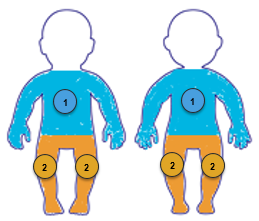 |
With each wipe, clean your child in this order:

Use a separate wipe or towel for the anus and for the face.
|
If your child weighs 20 - 60 pounds:
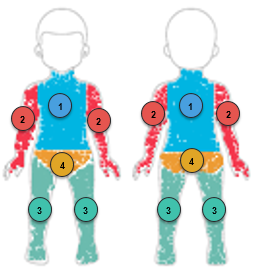 |
With each wipe, clean your child in this order:
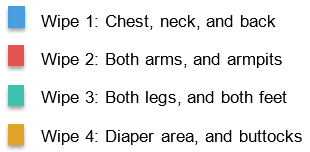
Use a separate wipe or towel for the anus and for the face.
|
If your child weighs over 60 pounds:
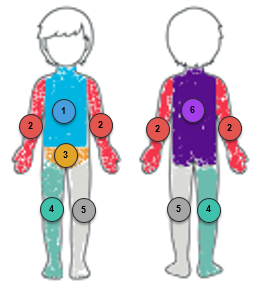 |
With each wipe, clean your child in this order:
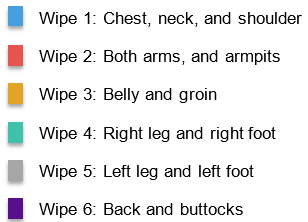
Use a separate wipe or towel for the anus and for the face.
|
Using AquaGuard® Safely
AquaGuard® is a clear barrier that covers your child’s central line dressing. It keeps the central line dressing dry and safe when your child takes a shower. Below are instructions for using AquaGuard® safely with your child.
Important things to know before using AquaGuard®:
- Do NOT use for swimming.
- Do NOT use for bathing.
- Do NOT use lotion or cream before applying. The skin must be dry and clean.
- AquaGuard does not replace the central line dressing.
- Each time you use AquaGuard, throw it away after use. Do not use the same AquaGuard® more than once.
- If your child gets a rash or irritation from the AquaGuard, remove it right away. Contact the care team.
Putting AquaGuard® on Your Child
|
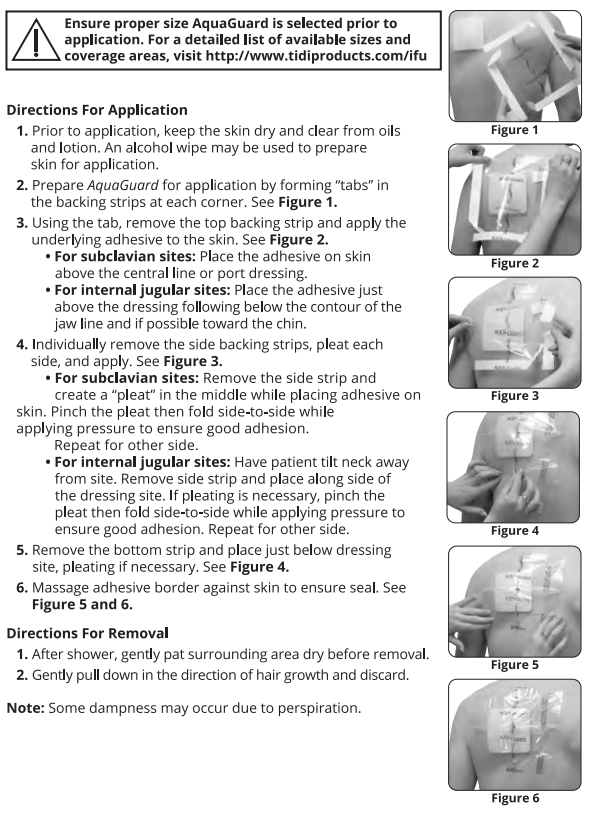
Source: Tidi Products
|
Using Care A-Line Sleeve
Care A-Line sleeves help keep your child’s central line secure, comfortable and safe. If the Care A-Line sleeve gets dirty or wet, you can change it. You can wash and reuse a Care A-Line sleeve.
|
PICC Sleeve Instructions
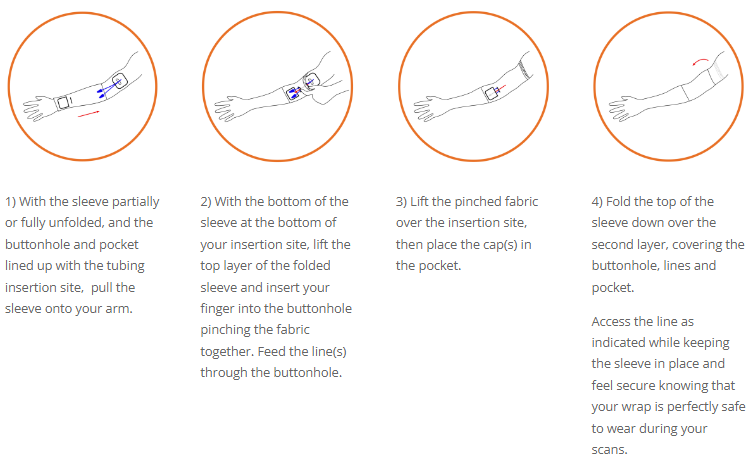
|
|
Central Line Wrap Sleeve Instructions
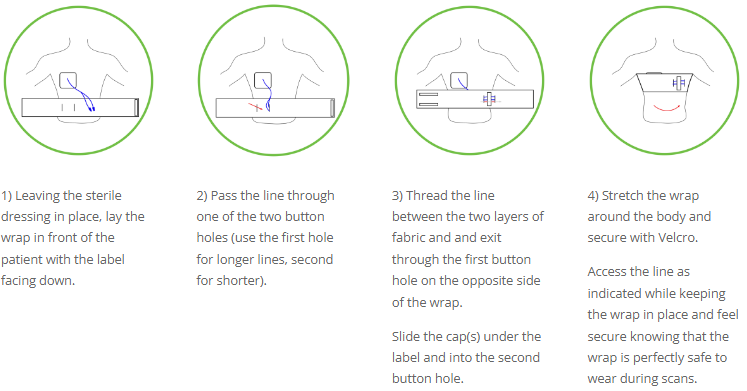
|
|
For more info, visit: https://carealine.compatientinfo/
|
When the IV Tubing Leaks
Your child’s IV tubing on their central line may leak if the tubing snaps or becomes loose. If it does, clamp the line using the plastic device on the tubing first. Contact your child’s or Clinic afterwards.
If the plastic device does not work or the tubing continues to leak, use the Hemostat Clamp, an emergency green plastic clamp (see picture below) and go to your nearest emergency room right away.
To use Hemostat clamp:
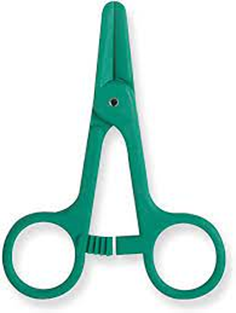
- Put your thumb and middle finger into the loops.
- Put the jaws of the clamp above the break of the I.V. tubing.
- Squeeze down on the loops with your thumb and middle finger until you hear three clicks and/or if the IV tubing stops leaking.
Cleaning the Lines
Wiping the IV tubing (lines) is one way to keep germs (bacteria) from getting into your child’s central line and causing an infection. The way you wipe the lines is very important. Follow the instructions below two times per day and more if needed (if the IV tubing is dirty/soiled).
Instructions:
- Wash hands with soap and water (see Effective Handwashing section).
- Put on gloves (see Using Gloves Safely section).
- Put the pad on the I.V. tubing near the central line site (where needle enters skin).
- Place an alcohol wipe close to the central line site.
- Gently wipe down the line starting at the site and moving away from the body towards the CADD pump. (You are wiping germs awayfrom the central line site, not toward it.)
- Throw away used alcohol wipe in garbage.
- Throw away used gloves in garbage.
- Wash hands with soap and water (see Effective Handwashing section).

Chemotherapy Spills
While it’s good to avoid any spills of chemotherapy medication, it can happen. The Chemo Spill Kit in your Take Home Bag has all the supplies you need to clean up a chemo spill. Please follow the instructions carefully to avoid contact (exposure) with the chemo medication as much as possible.
Instructions (Source: Infusystem):
- Stop the infusion.
- Clamp the pump tubing.
- Clean the Hazardous drug spills immediately. Wear protective gloves and blot the spill dry with the absorbent pad (included in the kit.) Clean the area three times with soap and water.
- Dispose of all materials used for clean-up into the Ziplock chemotherapy plastic bag.
- Remove clothing soiled with the medication right away.
- When handling bed linens or clothing soiled by medication, do not touch the spilled area with your bare hands. Immediately place the linens or clothing in the washing machine. Wash items separately from other laundry in hot water. If you are unable to wash these items right away, put them in a sealed plastic bag until they can be washed. Keep away from people and pets.
- Call the clinic to tell them about the spill.
If chemotherapy medication gets in your skin/eyes (or your child’s eyes):
- Wash the area very well with soap and water; then dry the area. Observe the skin for the next 7 days. If irritation or redness occurs, contact the doctor.
- If the medication splashes into your or your child’s eyes, flush eyes with tap water for at least 15 minutes. Then contact the doctor.
Throwing away (disposing of) chemotherapy exposed items:
- Put all supplies that had direct contact with the chemotherapy medication in a specially marked chemotherapy or hazardous waste bag.
- Seal the waste bag, keep away from people and pets. Return bag to the physician’s office for proper disposal.
Central Line and CADD Safety:Common Questions
It’s important to keep your child’s IV tubing and CADD pump safe. Here are answers to common questions from families on how to do so.
How do you keep your child’s IV tubing and CADD Pump safe when your child is sleeping or showering?
- Put the IV tubing and CADD pump in a position, so it will not tangle, get dirty or be stepped on.
- If the IV tubing gets wet, wipe with an alcohol pad using the instructions on Wiping the Lines.
The dressing on the central line is peeling off. What do you do?
- Make sure the area around the central line site is dry and clean.
- Apply a new Tegaderm dressing over the area where the dressing is peeling off. Tegaderm is in your child’s Take Home Bag.
- Call your child’s care team.
Can your child swim with a central line?
- No. There is a dangerous risk of infection to your child’s central line if they swim in pools, hot tubs, oceans, lakes or rivers.
What should you do if you hear a continuous high-pitched sound alarm from the CADD pump?
- Check the screen for a high-pressure warning.
- Check the tubing to ensure that it is not bent.
- Restart the pump by holding the START/STOP button. You will see 3 sets of dashes (--- --- ---) and then RUN will appear. Run tells you that the infusion is starting again.
- If the alarm does not stop, contact the clinic right away.
There is redness near the central line site. What do you do?
- This could be a sign of infection. Call your child’s care team right away.
If you have any questions, call your child’s doctor or care team.
©2023 NYU Langone Health. All rights reserved. Reviewed for health literacy. This information is not intended as a substitute for professional medical care. Always follow your health care provider's instructions.
Created in partnership with families and expertise from our Sala Institute for Child and Family Centered Care.